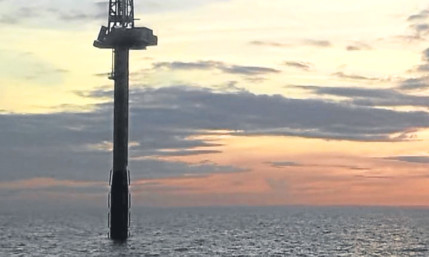Six huge offshore windfarms planned for the east coast could help generate enough “green” energy to power every home in Scotland and bring in millions of pounds, a renewables trade body has claimed.
The first steps to deliver these projects all of which have now received planning consent from the Scottish Government are under way.
The first piece of infrastructure was installed on the site of a windfarm 15km off the Angus coast towards the end of last year.The Inch Cape Offshore Wind Farm in the outer Firth of Tay will comprise up to 213 turbines.
A meteorological (met) mast will record wind conditions for around two years before the first turbines are installed, with work planned for late 2016 or early 2017.
Lindsay Leask senior policy manager at Scottish Renewables, said Inch Cape was “an exciting part of plans which would make the east coast of Scotland a hub for offshore wind energy”.
She said: “The three most recently consented windfarms, which are to be built off the Fife and Angus coasts, will be made up of around 330 turbines.
“The economic impact on the region has the potential to be significant, and the environmental benefits of the projects could be substantial, too.
“These turbines will not only offset carbon emissions from fossil fuel power stations, which are causing the planet to warm, but will also bring jobs and investment to the region and, particularly, its ports and harbours.”
The Scottish Government estimates that the four offshore windfarms which most recently received consent in the Forth and Tay region alone could generate up to £1.2 billion for the Scottish economy.
During their construction it is estimated that they could support between 2,567 and 13,612 jobs.
Two other windfarms, in the Moray Firth, were given planning permission in January and together will have up to 326 turbines.
Methil is already home to one of the world’s largest offshore wind turbines.
The device, being tested by Samsung Heavy Industries, is almost five times as tall as the main mast on Dundee’s tall ship Discovery, and is capable of producing enough power for 4,800 homes.
Ms Leask continued: “In order to get planning consent, the developers of these projects who are each investing hundreds of millions, if not billions, of pounds have to comply with strict rules around how the developments affect not only other users of the sea, like fishermen, but the animals, plants and organisms that live in it.
“We now know more about what is happening beneath the waves off the coast of east Scotland than ever before.”
In total, the six offshore wind projects have the potential to almost double the amount of renewable electricity being generated in Scotland today.
Ms Leask added: “Renewables like wind power, hydro-electric schemes and solar panels provide almost half the electricity we consume in Scotland.
“In 2012, the latest year for which figures are available, the amount of climate change-causing carbon dioxide displaced by renewables in Scotland was the equivalent of that produced by every car, lorry, bus and train journey in a whole year.”
